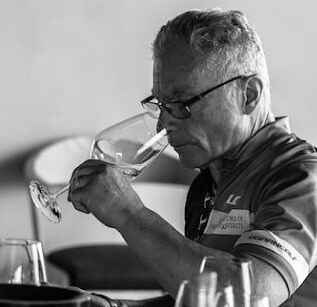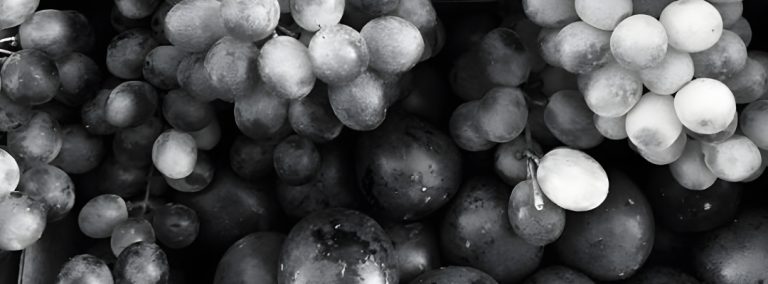Chilean wines are known for their high quality and good value. If you’re looking for a bottle of red wine to go with dinner, try a Cabernet Sauvignon from Chile’s Maipo Valley region and you won’t be disappointed. Chile also makes delicious fruit-forward Pinot Noir from vineyards located in the coastal regions of the Casablanca and Aconcagua Valleys, and they have top-rated red wine blends too that often include the country’s signature grape, Carmenere.
White wine from Chile tends to be vibrant with bright fruit and acidity. Chardonnay and Sauvignon Blanc are the most common whites, and you can get them at a much lower price point than similar wines from France and New Zealand. The prices are cheaper not because the wine is of a lower quality, but because land and labor are less costly, and Chilean wines don’t yet have the same prestigious reputation as the old and storied wine producing regions of France – though that’s not to say they won’t someday!
Top tier producers like Eduardo Chadwick and VIK Winery are making outstanding wines that rival First Growth Bordeaux and many French and Italian winemakers have also recognized the growing potential in Chile and bought land to start South America vineyards. Chile runs north to south along the Pacific Ocean and goes right up to the foothills of the Andes mountains. Vines benefit from cool breezes that keep pests and mold away, and hot days with a big variance in temperature from day to night.
You can find Chilean wines in most stores, though they’re less common in restaurants. Expect to pay $10-18 a bottle. A higher quality Cabernet or red wine blend can run anywhere from $20-30 up to $200. One thing to note is if you see Reserva, Reserva Especial or Gran Reserva, this means the wine was made with the best grapes from a vineyard, but it’s a grading system used by the winemaker and not an official designation.

What wines do they make in Chile?
Red Wine
- Cabernet Sauvignon. A Cabernet Sauvignon from Chile will often be dark ruby or violet in color and quite opaque, with concentrated fruit, including cherry, currant and blackberry. Expect long-lasting flavors with this wine and a good balance of acidity.
- Red Blends. A blended wine can have Carmenere, Cabernet Sauvignon, Syrah, Merlot and Petit Verdot in it. This is wine that can be aged. It will likely be full-bodied and richly flavored with berry and herbal notes.
- Carmenere. This is a big, full-bodied wine that’s opaque and violet in color. You’ll find raspberry and plum flavors with pepper notes, vanilla, and a hint of cocoa. You can also get sweet fruits like figs on the nose. Note, this grape blends beautifully with Cabernet Sauvignon and Syrah and tends to do better in warmer regions.
- Pinot Noir. Chilean Pinot Noirs are fruit forward with plum, strawberry and cherry notes and some herbs, oak and spice to them. These wines are made more in a light to medium-bodied style.
- Syrah. Chilean Syrah is really unique and has more French northern Rhône qualities, as opposed to Australian Shiraz. This wine can vary depending on which region it’s grown in but you can get black and red fruit with some leather and spice, and sometimes gaminess and hints of bacon fat.
- Merlot. If you’re looking for a lower-priced wine in a simple style, a Chilean Merlot will do the trick. This wine can have vanilla notes and be oak aged with a soft finish.
- Pais. Often described as a rustic wine, Pais is almost light brown in color and will have tart red fruit flavors with a silkiness to it.
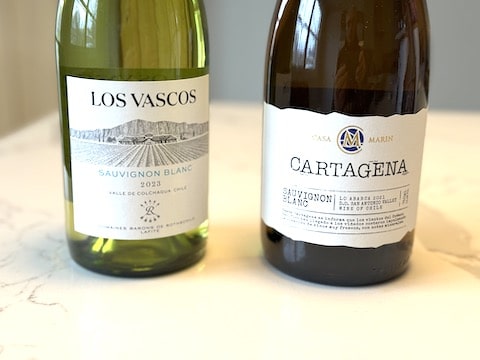
White Wine
- Chardonnay. Chilean Chardonnay can have a lot of lemon, honey and herbs. You might also find stone-fruit, like peach, with crisp and sharp acidity. These wines are more along the lines of Chablis, as opposed to a big oak-aged Chardonnay from California.
- Sauvignon Blanc. Sauvignon Blanc from Chile is generally citrus and grapefruit based, with stone-fruit and good minerality. You can get notes of melon in the nose, and tropical fruit. Sauvignon Blanc from the Casablanca Valley is a white wine often described as fresh and racy as it finishes with such bright acidity.
History of the Chilean wine industry
Chile has been growing European grape varietals since the 1500s when they were first colonized by the Spanish. In the late 1800s, the wine industry was heavily influenced by an influx of winemakers from France and Italy who brought over vines in an effort to avoid Phylloxera. These were people who really knew what they were doing and it’s one of the reasons why the country produces so many excellent Bordeaux blend style wines. However, it wasn’t until the late 1980s and early 90s that Chile really went through a wine renaissance and the quality of their wines at all price levels increased significantly. This coincided with some important European and Californian wineries investing heavily in the country. For example, one of the top Chablis producers bought vineyards in the coastal area of the Casablanca Valley region where conditions are similar to Burgundy, France and they are now making beautiful Chardonnays that aren’t as expensive as their French counterparts.
Wine History: Phylloxera is an insect that wiped out most of Europe’s vineyards in the 1860s and caused many winemakers from France to move abroad. Interestingly enough, due to its relative isolation as a land mass and climate conditions, Chile is one of the only countries in the world that really hasn’t had Phylloxera.
Geography and climate
Chile is unique in terms of its geography because it’s so long and thin. It’s 110 miles at its widest point and 2,600 miles long and is situated between the Pacific Ocean and Andes Mountains. To the north, there’s a desert, and to the south is Patagonia. Vineyards benefit from the cool Pacific air at night and morning fog that can extend ten to 12 miles inland (just like in the Sonoma region of California). Plus, while in many countries the valleys run north to south, in Chile almost every valley is west to east which helps funnel the cold air further inland.
They also get a lot of sunlight during the day. It’s been reported that Chile has more direct sun than any single wine growing area in Europe! The balance of heat units and the temperature change from day to night helps to give both their red and white wines more character and structure. Grapes are mostly planted on original root stocks and not grafted onto American native varietal roots. This allows for better control of vine vigor and time of ripening. Additionally, there’s a constant supply of wind both from the ocean and the mountains, combined with higher altitudes inland. This helps to keep fungus and pests off the vines.
Fun Fact: It’s not just the wine industry that benefits from these growing conditions. Chile has a thriving fruit and vegetable trade and as such they’re very protective of their agricultural industries. They have some of the strictest laws in the world regarding bringing fruit and vegetables in or out.
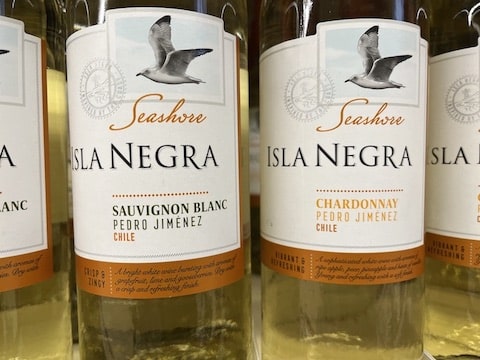
Why are Chilean wines so inexpensive?
Some people look at price as an evaluation of a wine’s quality but that’s not the case when it comes to Chile. Chile is the sixth largest producer of wine in the world and the “norm” is to find very large volume producers as opposed to the boutique (and much smaller production) of most Napa, Burgundy and Bordeaux wineries. Land and labor are also less expensive in South America, so costs are less and savings can be passed onto the consumer. Chile makes use of a lot of satellite imaging and aerial photos to help identify differences in soil types, support winemakers in making the best choices on what to plant where, and run more efficient harvests. Moreover, the unique climate means fewer pests and fungus can survive in vineyards, and that translates to a lot less money being spent on pesticides and other chemical treatments.
Wine growing regions
Chile is divided into several regions, from north to south Atacama, Coquimbo, Aconcagua, Central Valley and the Southern Region. Within each you can find specific valleys known for their wine production.
Maipo Valley
Maipo Valley is in the north of the Central Valley region and is divided into three sub regions. By the foothills of the Andes, the Alto Maipo has rocky soil which makes for elegant and bold Cabernets. Central Maipo is one of the oldest growing regions and it’s where many of the best Cabernet Sauvignon and Cabernet blends come from. Central Maipo gets higher amounts of heat, compared to Bordeaux and California. Not only does it have high temperatures, but there’s a huge variance in day to night temperatures, which benefits Cabernet grapes and adds complexity to the wine. By the ocean, Pacific Maipo has alluvial soils and produces reds with good acidity. Incidentally, you may have heard of the brand Concha y Toro – it comes from Maipo.
Colchagua, Cachapoal, Curico and Maul Valleys
All located within the fertile Central Valley Region to the southwest of Santiago, these areas are known for their red wines, including Cabernet Sauvignon, Cabernet blends and Carmenere. Particularly Colchagua stands out as producing top tier wines of some distinction and has been likened to Napa Valley.
Casablanca Valley
The Casablanca Valley is best known for its white wine production, both Chardonnay and Sauvignon Blanc, though they have recently started growing Pinot Noir here too. The cool climate and ocean breezes help the grapes develop slowly so they have a longer ripening period, which gives the wines more balance and complexity. The soils are sandy and well drained but there is also granite which lends good minerality, especially to the Sauvignon Blanc.
Aconcagua Valley
Known for its Cabernet Sauvignon, Syrah and Merlot production, the Aconcagua Valley extends from the highest mountain in the Americas, Mount Aconcagua, along the Aconcagua River to the ocean. Grapes grown here benefit from rocky soils and good breezes.
Elqui and Limari Valleys
The regions in the north tend to have more desert-like climates. While Elqui and Limari are best known for their Pisco production (as in what goes into a Pisco sour) you can now find some Syrah and Carmenere grown here.
Austral Region
This region is in the south and is one of the coolest areas bordering Patagonia. They’ve started growing Pinot Noir and Chardonnay here and some recognize the region as having a potential for sparkling wine production.
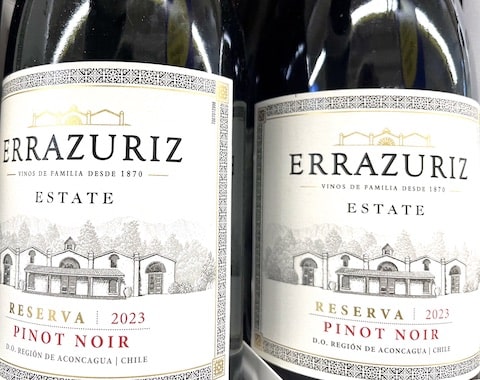
7 Things to know about Chilean wines
- Wines from Chile are high quality and not expensive. These are some of the best wines you can get for your money. The reason they are priced lower than European or Californian wines is more to do with production scale, the local economy, land and labor costs than anything else.
- Many vineyards are sustainably or organically farmed. This is due to the unique climate and geography of the country and the real emphasis in the wine, fruit and vegetable industries on being environmentally conscious and protecting the local ecosystem.
- Chile’s signature grape is Carmenere. You might mistake it for a Cabernet Sauvignon or Merlot, but it also has a hint of cocoa that sets it apart. You can have this wine with the same foods you’d pair with Bordeaux blend reds like steak and most barbecue foods. It’s something a bit different and gives you an opportunity to try a new grape varietal!
- Chile is known for its Cabernet Sauvignon. They also produce a lot of excellent Cabernet blends which are some of the country’s highest rated wines by international wine publications.
- They make Pinot Noir too. Their Pinot Noir can have mineral undercurrents with raspberry, strawberry and cherry and even a hint of spice. These are medium-bodied wines with great acidity that you can even serve with fish.
- Their Sauvignon Blanc will be in a French style but cost you a lot less than Sancerre. Sauvignon Blanc from Chile is often citrus or stone-fruit based with good acidity, as opposed to the tropical fruit Sauvignon Blancs you can get from New Zealand. You can also find hints of melon.
- Pais used to be the most planted grape varietal. Pais, also known as Listan Prieto, is an old European grape that was brought over in the 1600s by the Spanish. It was mainly grown in the south and used to produce bulk red and rosé wine up until the early 2000s when a few producers began selecting Pais for higher quality production.
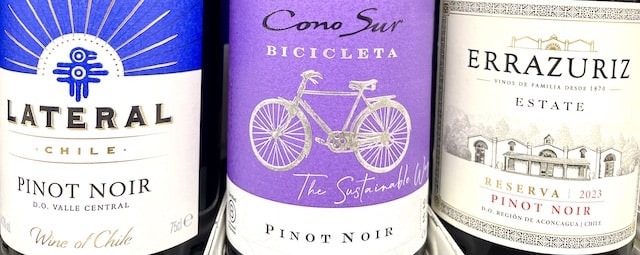
More on their Pinot Noir
Pinot Noir’s popularity as a red wine has grown significantly in the last 20 or so years and luckily some of Chile’s coastal regions offer perfect growing conditions for the grape. They started planting Pinot Noir about 15 years ago and you can now find a number of Pinot Noir producers to choose from. You might pay around $13-20 for a bottle which is excellent for the quality level of the wine.
The tale of the wrong grape
Like Malbec for Argentina, Carmenere is an old Bordeaux blend varietal that has become the signature wine of Chile. However, how this came to be is quite a funny story. Prior to the mid 1990s, Chile was growing a lot of Merlot that didn’t taste quite right. Something seemed off and after further investigation it was revealed that about 50% of the supposed Merlot was in fact an entirely different grape called Carmenere! This grape needed to stay on the vine longer, and as it was being harvested too soon, the wines weren’t very good. The error was corrected and the rest is history.

